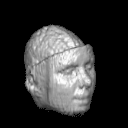![]()
|
BLaC-Wavelets stands for Blending of Linear and Constant wavelets.
It consists of a one-parameter family of wavelets that performs
a blend between Haar- and Linear wavelets. BLaC wavelets enables
the user to choose his own compromise between the smoothness
and the sharpness of the approximations.
With the blending parameter d which can vary between d=0 (constant case) and d=1 (linear case) one obtains the following results: The BLaC-Wavelet for various values of the blending parameter.
Click for a gif movie file Click for an mpeg movie file Partial reconstructions of an image data set.The upper three images are reconstructed using 1% of the wavelet coefficients. An edge detection algorithm was then applied to produce the lower images. They show clearly the effect of the blending parameter: the approximations become smoother as d increases. On the upper images, it can be seen that fuzzy areas appear for d = 1 .(left: d=0, middle d=0.5, right d=1)  Click for a 768x512 gif image (250Kb)
Click for a 768x512 gif image (250Kb)
Partial reconstructions of a volume data set.The BLaC multiresolution analysis was developped for use in the area of scientific visualization where large data sets should be analyzed and visualized. An example of BLaC multiresolution visualization of a volumetric data set is shown on the next pictures. These pictures were obtained using the Stanford Volpack volume renderer, and show the partial reconstructions of a volume data set, using 1% of the wavelet coefficients, for different blending parameters d (see explanations at the top of this page).(from left to right: d = 0., d = 0.43, d = 0.7, d = 1. ) 



Click for 512x512 gif images (90Kb each) |
![]() Return to
George-Pierre Bonneau's homepage.
Return to
George-Pierre Bonneau's homepage.